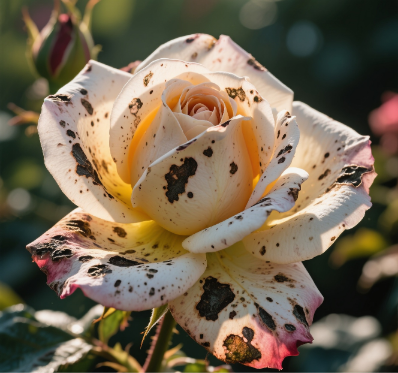Plant diseases pose a significant threat to global agriculture, and fungal and bacterial infections are among the most destructive. For example, wheat production in the United States suffered losses of over $3 billion in 2020 due to fungal diseases alone. Misdiagnosis of these pathogens can lead to ineffective treatments, increased chemical resistance, and substantial economic losses. This article aims to empower farmers and agronomists with proactive disease control strategies by providing a clear comparison of fungal and bacterial diseases, outlining key differences, diagnostic methods, and science-based management strategies.
Key Differences: Fungal vs. Bacterial Diseases
| Characteristic | Fungal Diseases | Bacterial Diseases |
| Pathogen Type | Eukaryotic (hyphae, spores) | Prokaryotic (rod-shaped bacteria) |
| Transmission | Air, water, soil, infected debris | Water splash, insects, tools, seeds |
| Infection Sites | Leaves, stems, roots, fruits | Natural openings (stomata) or wounds |
| Visual Signs | Powdery mildew, rusts, molds, sclerotia | Water-soaked lesions, ooze, rot |
| Environmental Triggers | High humidity, moderate temps (15–25°C) | High humidity + heat (>25°C) |
| Management | Fungicides (e.g., azoxystrobin, tebuconazole) | Copper-based bactericides, antibiotics |
2. Diagnosing Fungal Diseases
- Common symptoms:
Necrosis: Localized tissue death (e.g., Fusarium wilt in cotton and Rhizoctonia root rot in wheat).
- Rot: Soft decay with visible mycelium (e.g., Botrytis gray mold on grapes).
- Wilting: Vascular blockage (e.g., Verticillium wilt in tomatoes).
- Spores/fruiting bodies: Powdery mildew (white dust) and rusts (orange pustules).
- Leaf distortion: Deformed leaves caused by a fungal infection (e.g., clubroot in cruciferous plants).
- Diagnostic tips:
- Observe “fuzzy” mycelium growth under humid conditions.
- Identify spore colors (white, black, or orange).
- Note progressive damage with slow spread unless spores disperse.
3. Diagnosing Bacterial Diseases
- Common symptoms:
- Leaf spots: – Angular, water-soaked edges (e.g., Pseudomonas on cucumbers)
- Blight: Rapid necrosis (e.g., Xanthomonas leaf blight in rice).
- Soft rot: Slimy decay with a foul odor (e.g., Pectobacterium in potatoes).
- Wilting: Vascular clogging (e.g., Ralstonia wilt in tomatoes).
- Tumors/galls: Abnormal growths (e.g., Agrobacterium crown gall).
- Diagnostic tips:
- Perform the “ooze test”: Cut a stem. If a bacterial infection is present, a sticky exudate will be released.
- Confirm the absence of fungal structures. Lesions will appear greasy or waterlogged.
- Monitor for rapid progression in warm, wet conditions.
4. Science-Based Management Strategies
- For fungal diseases:
- Preventive fungicides: Use chlorothalonil for early blights and triazoles (e.g., propiconazole) for rusts and powdery mildew.
- Cultural controls include implementing crop rotation (two or more years with non-host crops) and reducing leaf wetness through drip irrigation and plant spacing.
- Biological controls: Utilize Trichoderma spp. for soil-borne fungi. Trichoderma spp. can be applied as a soil drench or seed treatment. A study in Brazil showed a 30% reduction in disease incidence when Trichoderma spp. were applied as a seed treatment in soybeans. Mix Trichoderma with organic matter and apply it uniformly to the soil.
- For bacterial diseases:
- Copper-based sprays: Apply copper hydroxide (e.g., Kocide®) to treat leaf spots. Avoid overuse to prevent copper resistance.
- Sanitation: Sterilize tools with bleach or ethanol, and remove infected plants promptly.
- Resistant varieties: Choose tomato hybrids with the Bs2 gene for bacterial spot resistance.
5. Addressing Co-Infections:
In intensive farming systems (e.g., greenhouses), fungal-bacterial co-infections are common (e.g., Fusarium and Ralstonia wilt in tomatoes). Strategy:
- Prioritize bacterial control first (due to faster spread).
- Combine treatments by using copper and mancozeb products for dual protection.
- Avoiding Common Mistakes
- Misdiagnosing pathogens: Applying fungicides to bacterial infections.
- Overreliance on single-mode chemicals: This accelerates resistance.
- Neglecting soil health: Pathogens thrive in compacted soils with low organic matter.
Conclusion: Proactive Disease Management Wins
- Diagnose accurately. Use symptom guides and lab tests when uncertain.
- Rotate chemistries. Diversify fungicides and bactericides to delay resistance.
- Integrate biocontrols. Bacillus subtilis suppresses both fungi and bacteria.
- Final tip: Scout early and treat preventatively. Pathogens are easier to stop than cure.
Understanding these differences and adopting integrated management practices allows farmers to reduce unnecessary chemical sprays, save costs, and protect yields sustainably. Knowledge, precision, and proactive strategies are the keys to resilient crop production.









